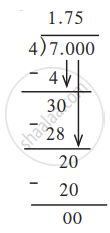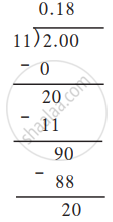Topics
Number System
Integers
- Concept of Integers
- Multiplication and Division of Integers
- Properties of Operations on Integers
- Concept for Commutativity, Associativity, Existence of Identity
- Inverse and Distributivity
- Problem Solving Using Operations on Integers
- Statement Problems on Integers Using All Fundamental Operations.
Rational Numbers
- Rational Numbers
- Word Problems on Rational Numbers (All Operations)
- Decimal Representation of Rational Numbers
- Concept for Problem Solving Using Operations on Rational Numbers
- The Decimal Number System
Fractions (Including Problems)
- Concept of Fractions
- Concept for Fraction as an Operator
- Concept of Reciprocal or Multiplicative Inverse
Decimal Fractions (Decimals)
- The Decimal Number System
- Concept of Multiplication
- Division of Decimal Numbers
Exponents (Including Laws of Exponents)
- Concept of Exponents
- Concept for Exponents Only Natural Numbers.
- Laws of Exponents (Through Observing Patterns to Arrive at Generalisation.)
- Concept for Application of Laws of Exponents in Simple Daily Life Problems
Commercial Arithmetic
Ratio and Proportion (Including Sharing in a Ratio)
Unitary Method (Including Time and Work)
- Concept of Unitary Method (Including Time and Work)
- Unitary Method Continued, Consolidation, General Expression for Unitary Method .
- Relation Between Speed, Time and Distance
Percent and Percentage
- Basic Concept of Percentage
- Concept for Understanding Percentage as a Fraction with Denominator 100
- Conversion between Percentage and Fraction
- Converting Decimals to Percentage
Profit, Loss and Discount
- Concept of Discount
- Concept for Application to Profit and Loss (Single Transaction Only)
Simple Interest
Algebra
Fundamental Concepts (Including Fundamental Operations)
- Fundamental Concepts
- Terms, Factors and Coefficients of Expression
- Algebraic Expressions
- Performs Operations (Addition and Subtraction) on Algebraic Expressions with Integral Coefficients Only.
Simple Linear Equations (Including Word Problems)
- Simple Linear Equations in One Variable
- Simple Linear Equations in One Variable
- Concept for Inequalities
- Concept for Solution of Simple Inequalities in One Variable
Set Concepts (Some Simple Divisions by Vedic Method)
- Concept of Set Concepts
- Concept for Revision Idea of Sets
- Universal Set
- Concept for Cardinal Property of Sets
Geometry
Lines and Angles (Including Construction of Angles)
- Introduction to Lines and Angles
- Concept for Pairs of Angles
- Properties of Parallel Lines
- Construction of a Line Parallel to a Given Line from a Point Outside It .
Triangles
- Concept of Triangles
- Concept for Angle Sum Property
- Concept for Exterior Angle Property
- Concept for Construction of Simple Triangles.
Pythagoras Theorem
Symmetry (Including Reflection and Rotation)
- Concept of Symmetry
- Concept of Reflection Symmetry
- Concept for Idea of Rotational Symmetry, Observations of Rotational Symmetry of 2-d Objects. (900, 1200, 1800)
Recognition of Solids (Representing 3-d in 2-d)
- Concept of Recognition of Solids
- Faces, Edges and Vertices
- Concept for Mapping the Space Around Approximately Through Visual Estimation.
Congruency: Congruent Triangles
- Congruence of Triangles
- Concept for Congruence Through Superimposition
- Extend Congruence to Simple Geometrical Shapes E.G. Triangles, Circles.
- Criteria for Congruence of Triangles
Mensuration
- Mensuration
- Concept of Perimeter
- Circumference of a Circle
- Concept of Area
- Concept of Measurement Using a Basic Unit Area of a Square, Rectangle, Triangle, Parallelogram and Circle, Rings and Combined Figures.
Data Handling (Statistics)
Data Handling
- Concept of Data Handling
- Concept for Collection and Organisation of Data – Choosing the Data to Collect for a Hypothesis Testing
- Arithmetic Mean - Raw Data
- Arithmetic Mean - Range
- Concept of Median
- Concept of Mode
- Concept for Constructing
- Interpretation of Bar Graphs
Probability
- Basic Ideas of Probability
- Concept for Feel of Probability Using Data Through Experiments.
- Concept for Notion of Chance
- Concept for Tabulating and Counting Occurrences
- Comparing the Observation with that for a Coin. Observing Strings of Throws, Notion of Randomness.
Notes
Decimal Representation of Rational Numbers:
1) Write the rational number `7/4` in decimal form.

(1) 7 = 7.0 = 7.000 (Any number of zeros can be added after the fractional part.)
(2) 1 is the quotient and 3 the remainder after dividing 7 by 4. Now we place a decimal point after the integer 1. Writing the 0 from the dividend after the remainder 3, we divide 30 by 4. As the quotient, we get now is fractional, we write 7 after the decimal point. Again we bring down the next 0 from the dividend and complete the division.
2) Write `2 1/5` in decimal form.
We shall find the decimal form of `2 1/5 = 11/5` in three different ways.
Find the decimal form of `1/5`.

∴ `1/5` = 0.2
3) Write the number `2/11` in decimal form.

∴ `2/11` = 0.1818.......
`2/11 = 0.bar18`
4) Work out the decimal form of `5/6`.

`5/6` = 0.833...
`∴ 5/6 = 0.8dot3`
Here, a single digit or a group of digits occurs repeatedly on the right of the decimal point. This type of decimal form of a rational number is called the recurring decimal form.
If in a decimal fraction, a single-digit occurs repeatedly on the right of the decimal the point, we put a point above it as shown here. `5/6 = 0.8dot3` and if a group of digits occurs repeatedly, we show it with a horizontal line above the digits. Thus, `2/11 = 0.bar18`.
